Is it “criminal” for your law firm not to use social media to grow business? The verdict is in, and the answer is a resounding yes. According to Demand Sage’s 2023-2024 social media data, the U.S. had 308.27 million social media users in 2023, with this number expected to rise to 335.65 million by 2029. Additionally, the American Bar Association’s (ABA) 2023 Website & Marketing Tech Report, (which surveyed practicing attorneys) shares that 84% of law firms still use social media to market their practices to this large, growing audience.
From increasing brand awareness, attracting client prospects, educating target audiences, and building brand authority, the long-term benefits of social media are undisputed across industries. Together with your law firm's website, platforms like Facebook, Twitter, LinkedIn, Instagram, TikTok, and YouTube can help grow your law firm.
In this article, we’ll highlight why social media for law firms is a necessity for your business, the best social platforms you can utilize, the do’s and don’ts of each, and how your law firm can increase its social media presence to help drive more leads.
Why do Law Firms Need Social Media?
In this digital era, social media continues to serve as a driver of business growth. Based on Demand Sage’s social media data, an average social media user has 7.1 accounts in the U.S. and spends an average of 2 hours and 20 minutes each day on different social media apps.
It’s a missed opportunity if your firm isn’t keeping up with the latest social platforms and/or regularly updating content to raise awareness and attract more clients to your personal injury firm. Plus, with the majority of attorneys using social as a way to boost leads and awareness, your firm can’t afford to lose business from competitors.
How to Establish a Law Firm Social Media Presence
Claim Your Profiles
A good social media page starts with claiming your name on every platform. Make sure you have the same name for every social media page. This will make it easier for people to find you across different sites.
Keep in mind that sometimes your top choice for a social media handle won't be available. If this happens, come up with two or three backup handle options and focus on keeping your handles consistent across social media platforms.
Choose a Unified, Consistent Look
When building your personal brand as an attorney, pick a unified color scheme, tone, and tagline. This will increase the recognition and general awareness of your law firm's brand. It’s also important not to change your look too often. Constant changes to aspects such as your logo image/colors may confuse prospects regarding your company's image.
The same goes for social media profiles. The branding should match the look and feel of your website. If a prospective client finds you on Facebook and navigates to your site, you want them to feel like they are viewing the same business—a key element of social media strategy for law firms.
Consider creating a unified brand style guide or social media brand guidelines as your team grows to ensure that no matter who is responsible for social media, your voice, aesthetic, and frequency stay consistent.
Build Credibility
Posting poor-quality content is as good as posting nothing at all. Everything you post should add value to your followers’ news feeds and be presented as unique and authentic—as these are important qualities clients look for in a personal injury attorney. Once you establish yourself as an expert, clients will follow. For example, blogs, podcasts, and industry insights are great ways to showcase your expertise. Publishing interesting content and posting it on social media can help attract new clients looking for the services you describe.
Five Best Social Media Management Tips for Law Firms
1. Develop a Content Plan
Social media strategy for law firms begins with a plan. Tell the story of your firm to keep readers engaged and entertained—while also providing the value of your practice. Below are some elements that you can include in your law firm social media strategy.
Define your firm’s content purpose
Are you trying to spread awareness and educate followers, or are you trying to convert clients at the bottom of the funnel? Different formats of content are good for achieving different goals, from securing new clients to simply educating the masses.
Develop content themes
Develop themes to keep your content fresh but familiar. Your social media themes can include legal advice, firm updates and announcements, client testimonials, safety tips, event/webinar promotions, and behind-the-scenes content from your team. This is especially important for social platforms that follow stricter image and video-only formats like Instagram, TikTok, and YouTube.
Post in different formats
Social media content for law firms should involve different formats, such as infographics, carousels, videos, GIFs, and podcasts. =
Include calls-to-action (CTAs)
At the end of each post, add a relevant CTA to drive readers to the appropriate page of your law firm’s website. This could include a CTA to read a full blog, link to a specific practice area page, or even to your team’s bio page.
2. Engage Your Community
Having a lot of followers does not mean they all see your content. Good social media management for law firms involves engagement. Once you have established a community of colleagues, clients, and business associates, interact with them. Ask your followers questions about topics relevant to them and your practice. This information will help you determine what your followers are most curious about. You can also strategically share other users’ posts or mention other users in your own content. For example, you could repost a positive shoutout or run a contest and share/tag the winner.
3. Remain Professional
Social media content for law firms should also remain as professional as possible. Use good judgment when posting online content, especially to your professional law firm's social media accounts. If you have others posting to your law firm’s feeds, establish guidelines on what is acceptable.
4. Manage Social Media from One Platform
Running several different social media accounts does not have to be time-consuming. Social media management tools like Sprout Social, Hootsuite, and Buffer allow you to manage your accounts all in one place.
5. Set and Measure Your Goals/Performance
Successful social media management for law firms is not complete without measuring the results of your posts. Each social media platform has key insights you can gather to see how your organic posts are performing, the number of followers you’ve gained, and whether your paid ads are resulting in a return on investment. Specifically, look at key stats such as reposts/retweets/shares and quality comments—not just likes. Also, see how many leads and website traffic you’re garnering as a result of your social posts. As a part of your social strategy, set monthly goals and pivot your content plan based on the data you gather.
Below are a few of the best social platforms your law firm can begin utilizing (if not already), as well as some key insights to make the most of each platform.
What are the Best Social Media Platforms for Law Firms?
As of 2024, there are over three billion monthly active Facebook users worldwide with this number expected to grow, according to Demand Sage statistics. Although other social media platforms have gained in popularity, law firm marketing with Facebook is still worthwhile. Per the ABA’s 2023 Website and Marketing Tech Report, 57% of law firms still use Facebook to promote their business. When posting on Facebook, a mix of organic and paid social posts toward your firm’s target audience is a great way to not only gain new prospects but to gauge live feedback via comments.
Facebook Do’s
Post frequently and in different formats such as text, video, and images.
Develop a content plan and schedule posts centered on a variety of educational content related to personal injuries, how your firm helps, and even about your business staff.
Be responsive to comments and questions in order to extend reach.
Facebook Don’ts
Don’t ignore advertising professional conduct rules around Facebook advertising. Check your firm’s local bar association for specifics. =
Don’t fail to regularly monitor key weekly and monthly metrics to discover what posts resonate most with your target audience.
Don’t forget to edit your posts for grammar, spelling, and punctuation before posting or scheduling a post.
Facebook Personal Injury Example Posts
Here are two personal injury law firm social media posts that showcase an event (raising awareness for the firm and benefiting the community) and a blog about what to do after a hit-and-run accident.

Video post credit: Witherite Law Group

X (Twitter)
Now officially named “X,” this platform (although not as popular as other social channels), is still a great marketing tool—particularly for engaging with your firm’s target audience. 33% of surveyed lawyers maintain a presence on X, according to the ABA’s 2023 Website and Marketing Tech Report. Facebook may reign king for unique posts, but using Twitter as an attorney is still a great way to market your firm (in 280 characters or less) and engage in meaningful (often real-time) conversations.
X (Twitter) Do’s
Use unique, specific hashtags related to your firm, such as #personalinjurylawsuit or #traumaticinjury, in order to extend your post’s exposure.
Carefully select who you follow and don’t just “follow everyone.” This ensures that you select people or businesses that care about your practice and are more likely to retweet or favorite your tweets.
Post short, but meaningful tweets around legal tips, testimonials, law firm wins, relevant legal updates, and industry updates. Also engage with other professionals to exchange insights.
X (Twitter) Don’ts
Don’t excessively promote only your firm. Although some self-promotion is good, focus on delivering more insights on X.
Don’t forget to engage with your audience. Since X is a very social platform, make sure to actively respond to mentions, direct messages, and retweets.
Don’t participate in heated debates or confrontations, as this could damage your firm’s professional reputation.
X (Twitter) Personal Injury Example Tweets
Here are two law firm social media posts that offer great examples of industry news and a testimonial.
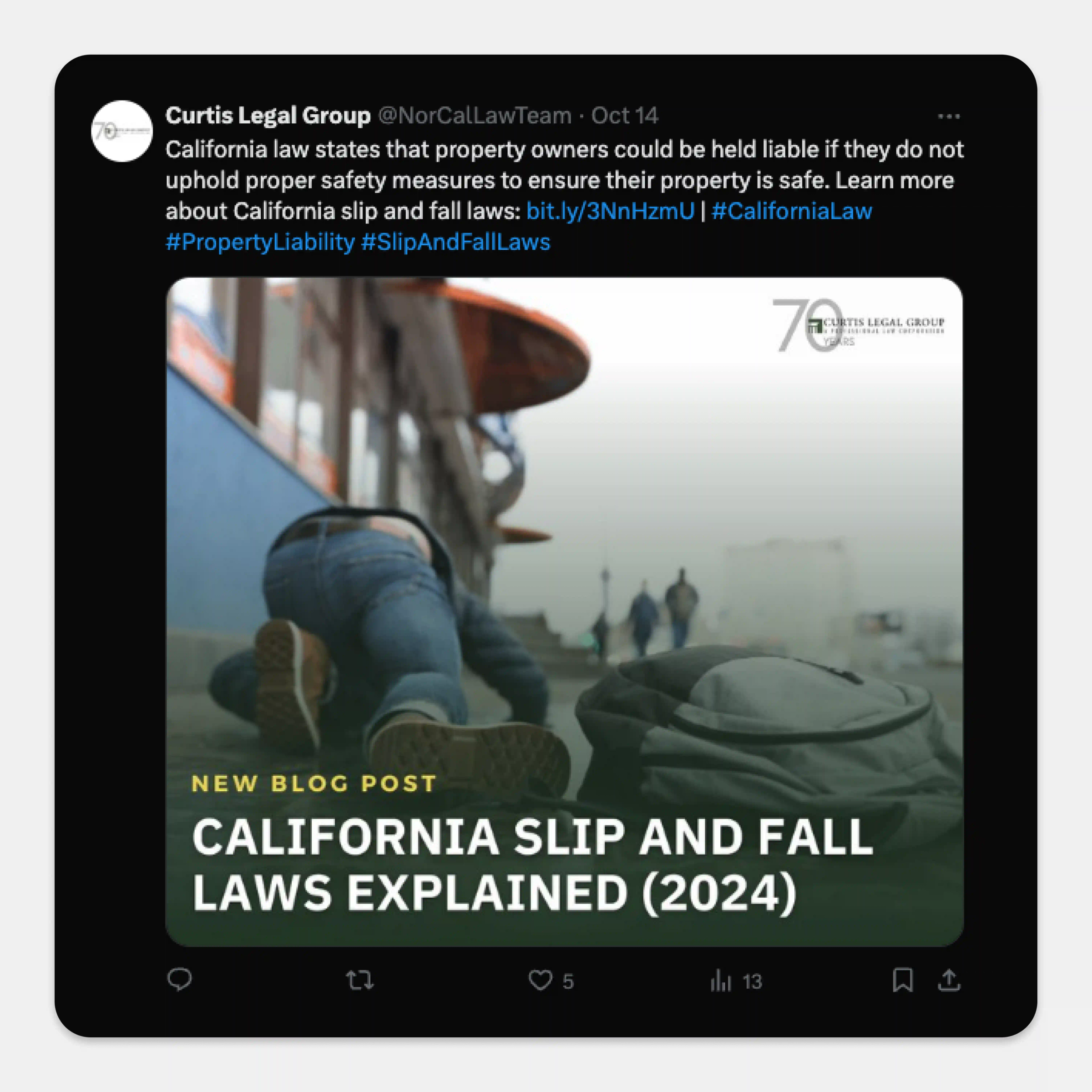
Post credit: Curtis Legal Group
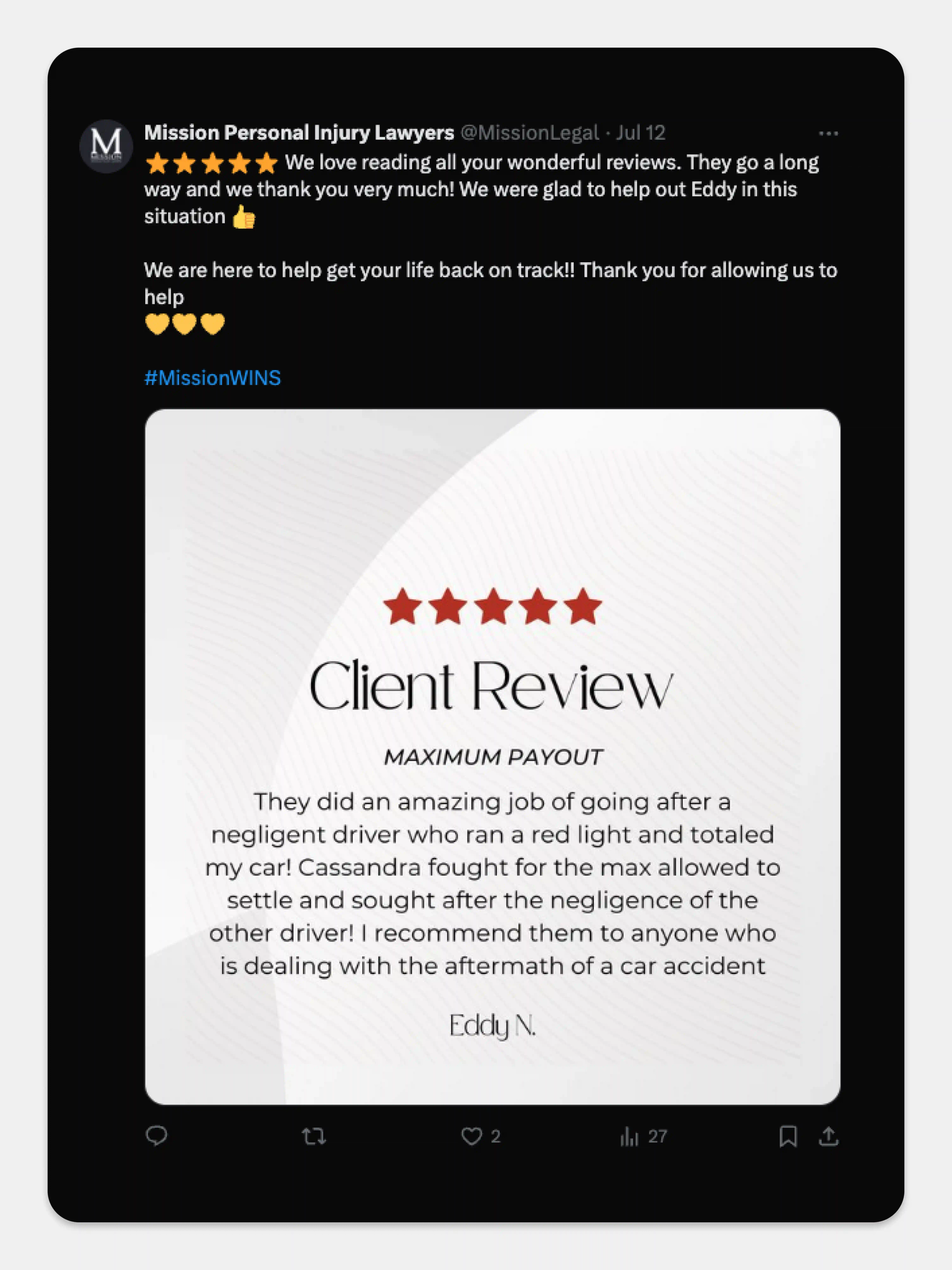
Post credit: Mission Personal Injury Lawyers
This social platform isn’t just a place to network and connect with colleagues, it’s also a great way to market your personal injury firm’s brand. According to the ABA’s 2023 Website and Marketing Tech Report, a whopping 83% of law firms have a presence on LinkedIn. With over 830 million members worldwide, LinkedIn is a social media tool that should be a part of your firm’s marketing arsenal.
LinkedIn Do’s
Keep up with industry news and events, and post timely updates—as many LinkedIn members use the platform to stay up to date on current news.
Post legal tips, as well as updates on your firm, which can include recent expansions and awards.
Provide a mix of eye-catching slideshows, videos, live Q&A sessions, and podcasts. Remember to use hashtags and invite audience members to leave comments.
LinkedIn Don’ts
Don’t just focus on selling your services; LinkedIn is more about building relationships than a platform for purchases.
Don’t fail to engage with the community. Like X, LinkedIn is heavier on conversations, so reply to comments and messages in a timely manner. Also, explore live conversations around your business and offer non-salesy advice.
Don’t forget to monitor metrics to see which posts result in the most engagement and drive the most reposts.
LinkedIn Personal Injury Example Posts
Below are a couple of great examples of slideshow and a podcast post from two different personal injury firms.

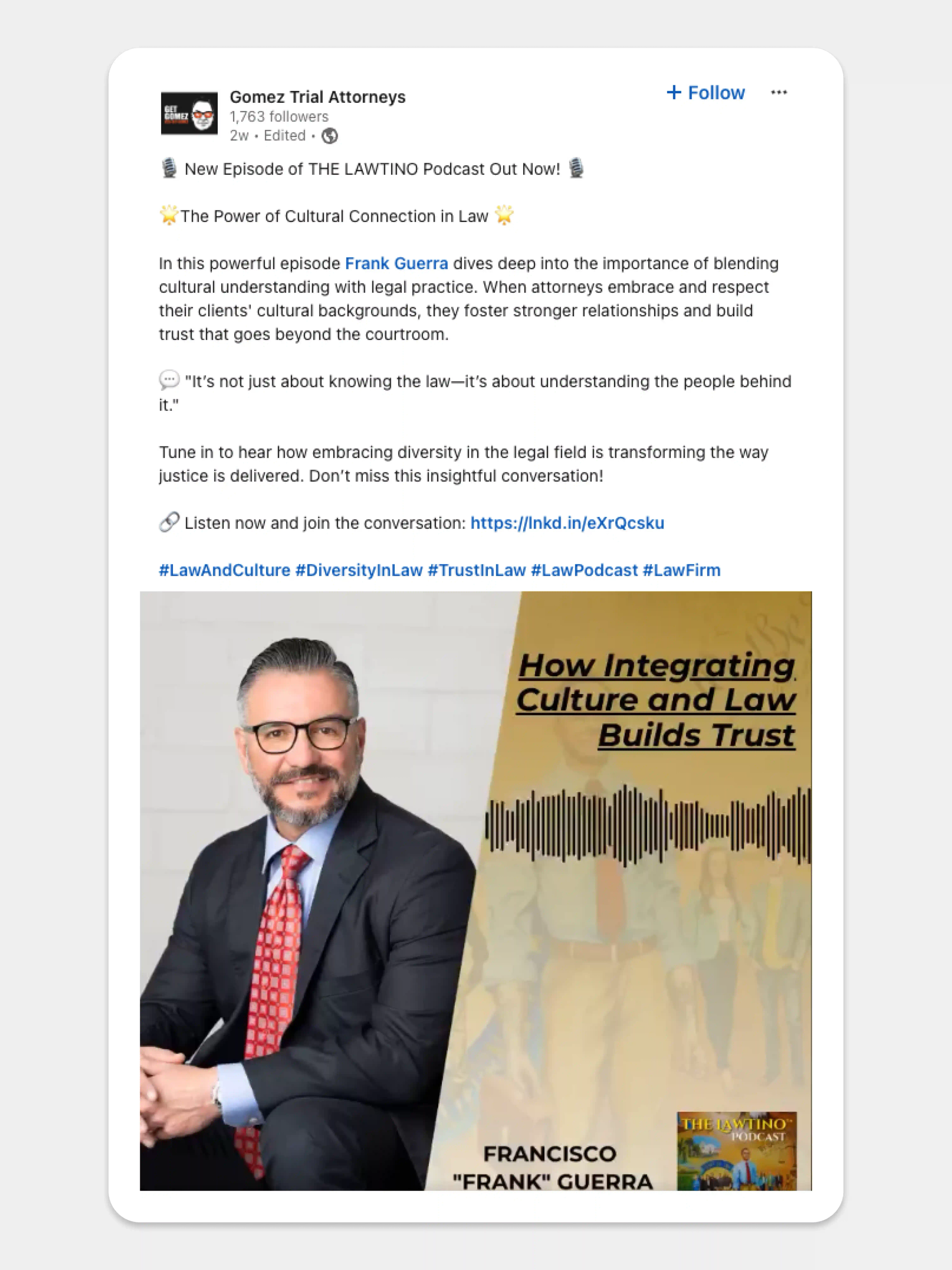
Post credit: Gomez Trial Attorneys
YouTube
Boasting 2.50 billion monthly active users, YouTube is the second most used social media platform behind Facebook. This social channel is primarily used to entertain and inform viewers with topics ranging from local new insights and movie reviews to DIY treehouse videos and fitness advice. Your law firm also has an opportunity to become a thought leader in the space while marketing legal expertise.
YouTube Do’s
Invest in a high-quality camera, microphone, and video editing software to create professional videos. To start off, you can save money by using a smartphone with advanced cameras.
Expand your reach by posting a mix of longer-form videos (to break down complex topics) and YouTube shorts—which are a maximum of 60 seconds.
Feature a wide variety of videos from podcasts, livestreams, Q&A sessions, and legal tips to maximize awareness and generate conversations.
YouTube Don’ts
Don’t post only advertorial videos about your business and how much money you won for clients.
Don’t feature videos that are shaky, hard to hear, and filmed from outdated video technology.
Don’t fail to keep up with YouTube algorithm shifts. Stay up-to-date and pivot your focus as often as possible to keep up with changes.
YouTube Personal Injury Example Posts
Here are two law firm social media posts that provide a good example of a long-form video that provides extended insight and a YouTube short that provides car accident tips.
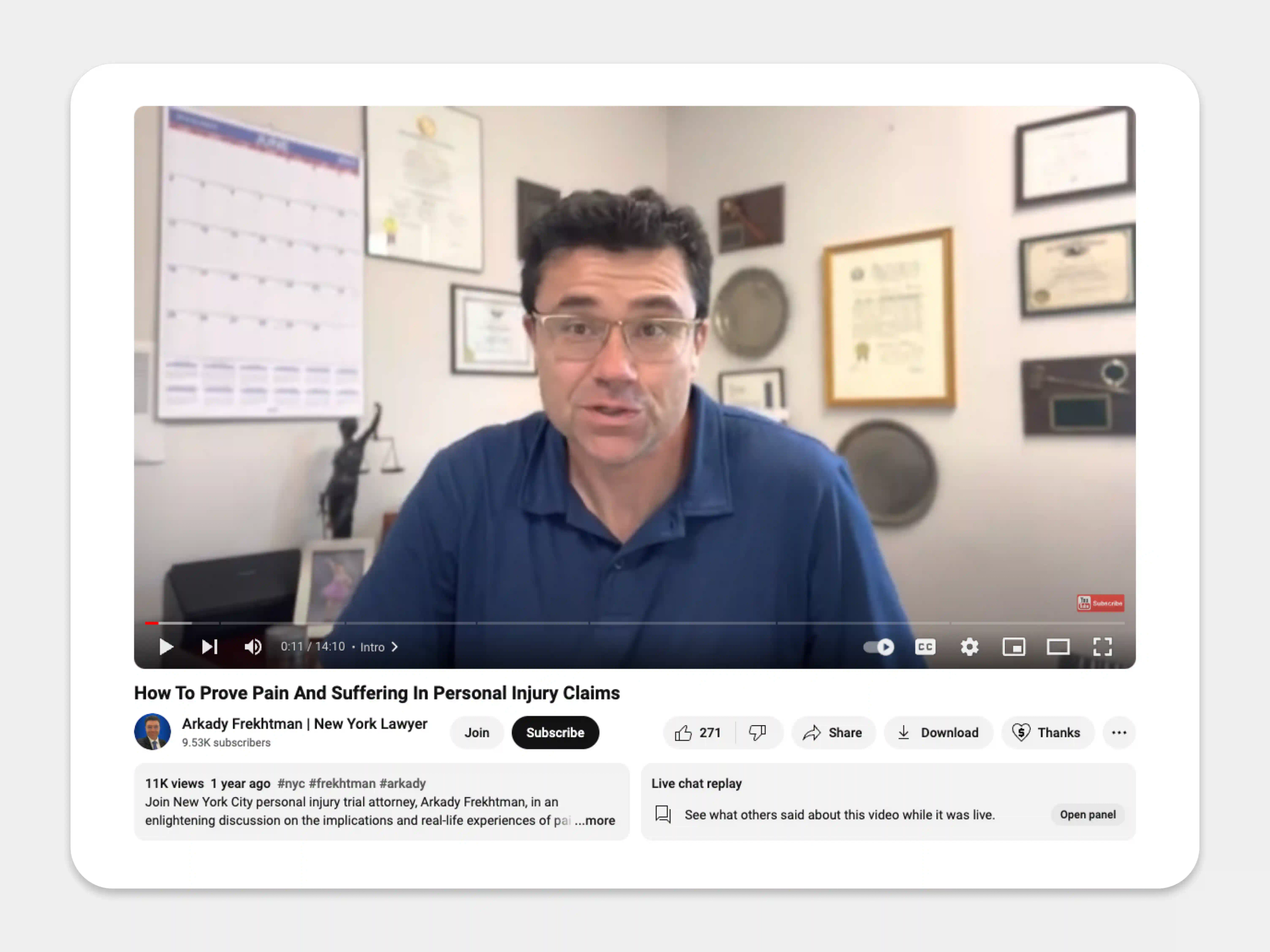
Video post credit: Frekhtman & Associates

Video post credit: Cruz & Payne Injury Lawyers, PC
Owned by Facebook, Instagram can serve as a unique way to market your law firm. With two billion monthly active users, don’t ignore the social channel—even if it’s limited to only images and videos. Overall, Instagram is a great way to provide “behind the scenes” posts of your firm and team and to offer tips for everyday situations.
Instagram Do’s
Post high-quality photos and videos with advanced cameras from a professional camera or a smartphone.
Include hashtags and location tagging (when applicable) on posts, stories, and reels to encourage engagement.
Use the platform to humanize your firm with images and videos of your firm’s culture and community work, in addition to legal tips (similar to a YouTube short).
Instagram Don’ts
Don’t focus on posts that aren’t informative and/or overly “salesy.”
Don’t expect immediate results. Social channels (especially Instagram, YouTube, and TikTok) can take time to build trust. The more informative and human your posts are, the more likely viewers are to like, share, and follow.
Don’t forget to keep your business and personal Instagram accounts separate. Although the aim here is to be as human as possible, you still need to maintain a professional image and keep personal views and opinions at bay.
Instagram Personal Injury Example Posts
Below are posts from two different personal injury firms. Both use a human angle to raise awareness and generate engagement.

Video post credit: Jurewitz Law Group
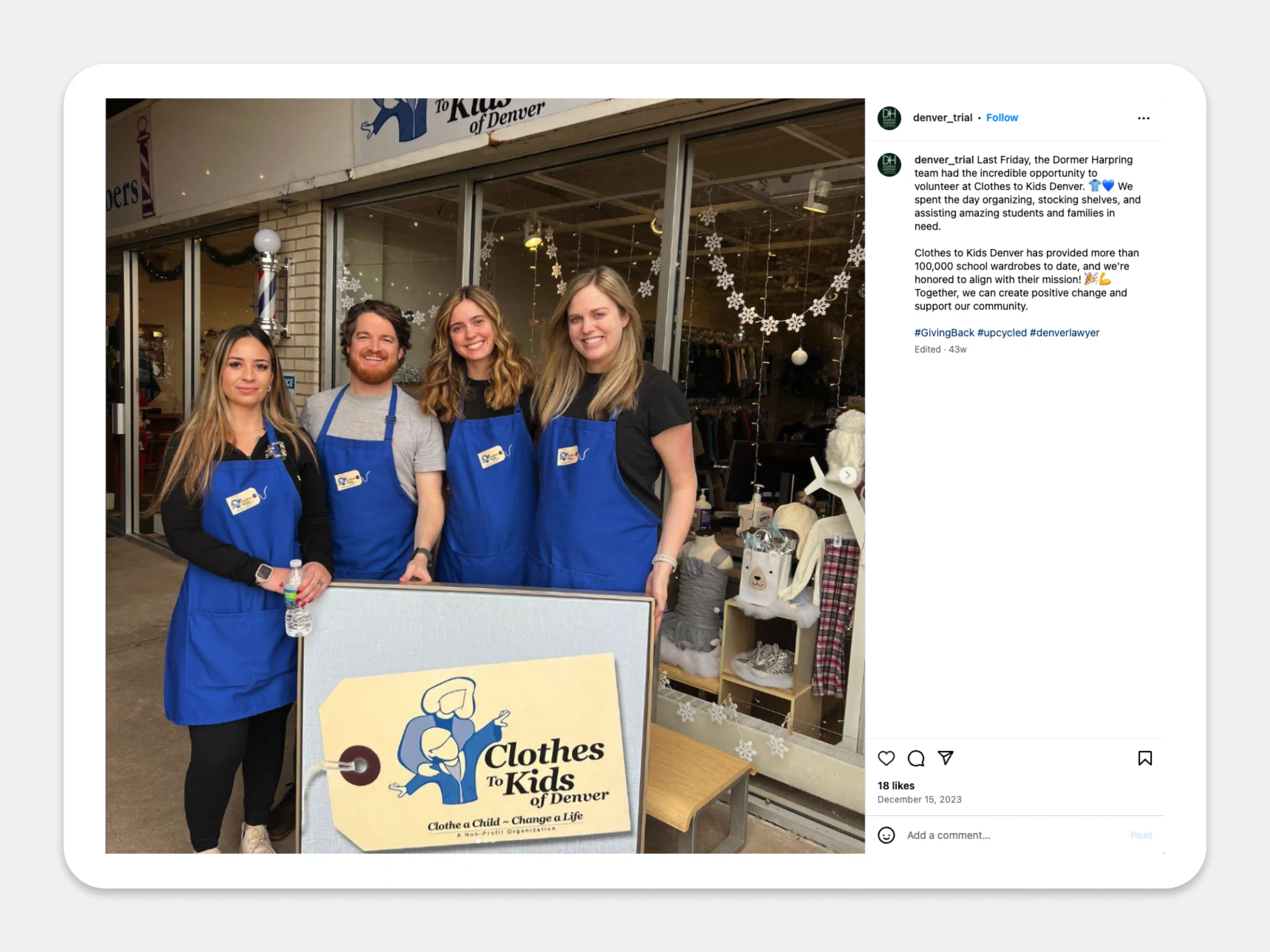
TikTok
The newest social media app and often considered “the trendiest,” TikTok is one of the best ways to show your law firm's personality with candid content. The social media channel generated 232 million downloads globally during the last quarter of 2023, making it one of the most downloaded (and engaged) apps. As this number is expected to grow, your law firm can successfully increase brand awareness and even market business on the platform.
TikTok Do’s
Explore TikTok’s unique features, such as “duet,” which allows your firm to react to content, and LawTak, a legal segment where you can promote your firm.
Follow the latest trends and put your unique legal spin on it—just remember to remain appropriate.
Engage in a trendy, entertaining angle in your posts. This can include starting off with a question or inserting your insight into a controversial, related (but still professional) topic.
TikTok Don’ts
Don’t misuse trends and viral challenges. While entertainment is the name of the game for TikTok, you still want your content to remain appropriate and contain an element of professionalism.
Don’t forget about ethical standards (to avoid compromising your reputation) during posts—such as engaging in misleading tactics to attract clients.
Don’t neglect advertising guidelines set by your state bar association. Check with your local bar regularly to ensure you remain in compliance.
TikTok Personal Injury Example Posts
Check out these two posts that use an angle of entertainment to provide legal tips and advice.

Video post credit: Rafi Brown | Stokes
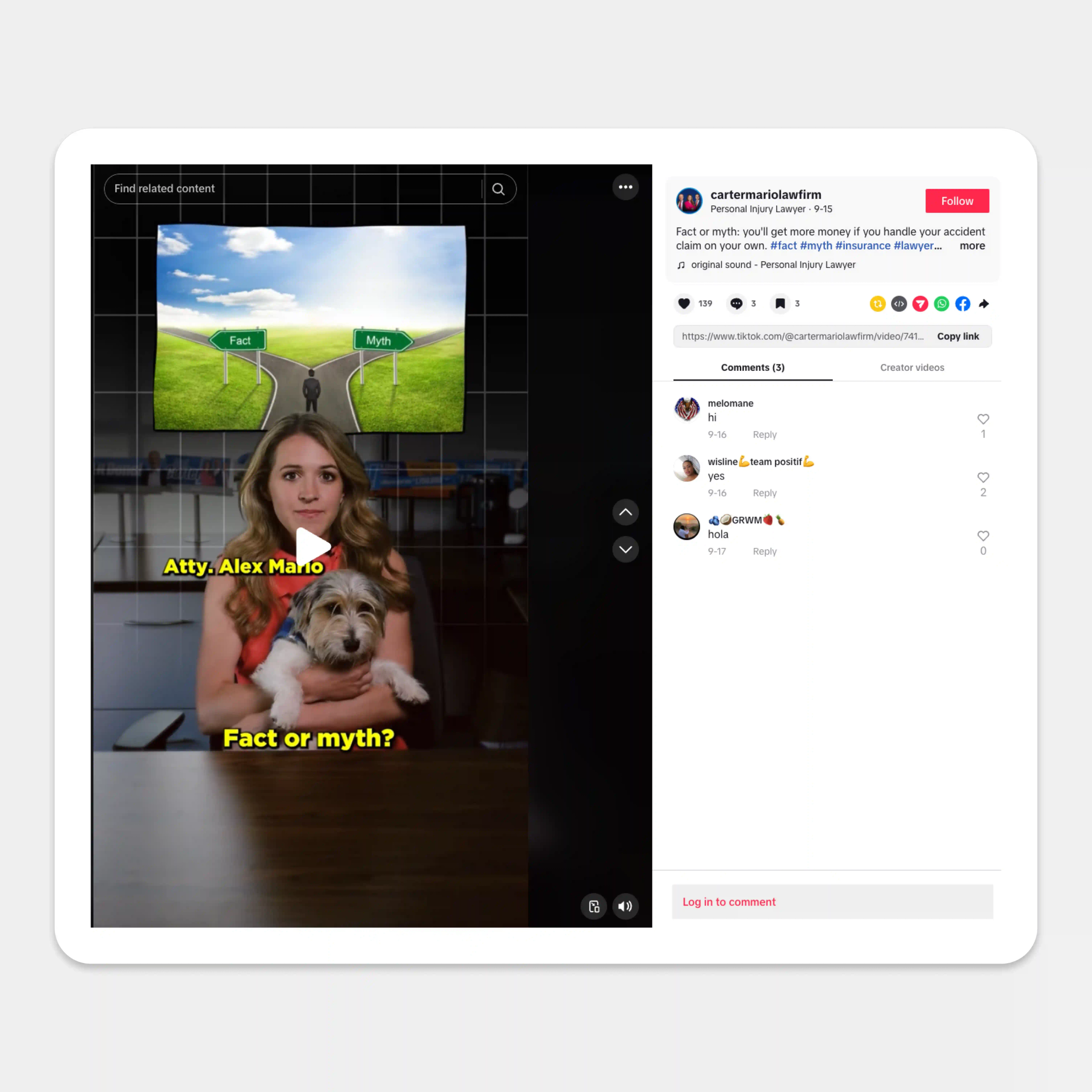
Video post credit: Carter Mario Law Firm
Each social media platform has a specific purpose and use to help boost brand awareness of your firm and help drive leads over time. As part of your social engagement, be sure to answer all questions and respond to negative reviews—in addition to positive comments. This tactic shows viewers that you care about each opinion and that your firm is responsive to all feedback, whether positive or negative.
How CASEpeer Can Complement Your Personal Injury Firm’s Social Media Strategy
Social media for law firms should encompass a proper strategy, adequate planning, and active monitoring of comments and metrics. CASEpeer can help convert lead prospect traffic from social media into conversions with customizable intake forms. Easily embedded directly into your firm’s website, CASEpeer’s intake forms help ensure that no potential client slips between the cracks. Once a prospect fills out the form and chooses to use your firm, you can easily finalize onboarding with eSignatures.
Managing cases is also a breeze with CASEpeer’s client portal, which allows you to easily share updates, documents, deadlines, and general communication from a secure source. Paired with case management features such as automated workflows, medical treatment tracking, calendar management, and AI, your firm will be able to provide the best service from case start to case close.
Try CASEpeer today with a free demo and see why this is the best case management solution built specifically for personal injury attorneys.
About the author

Adrian AguileraContent Writer
